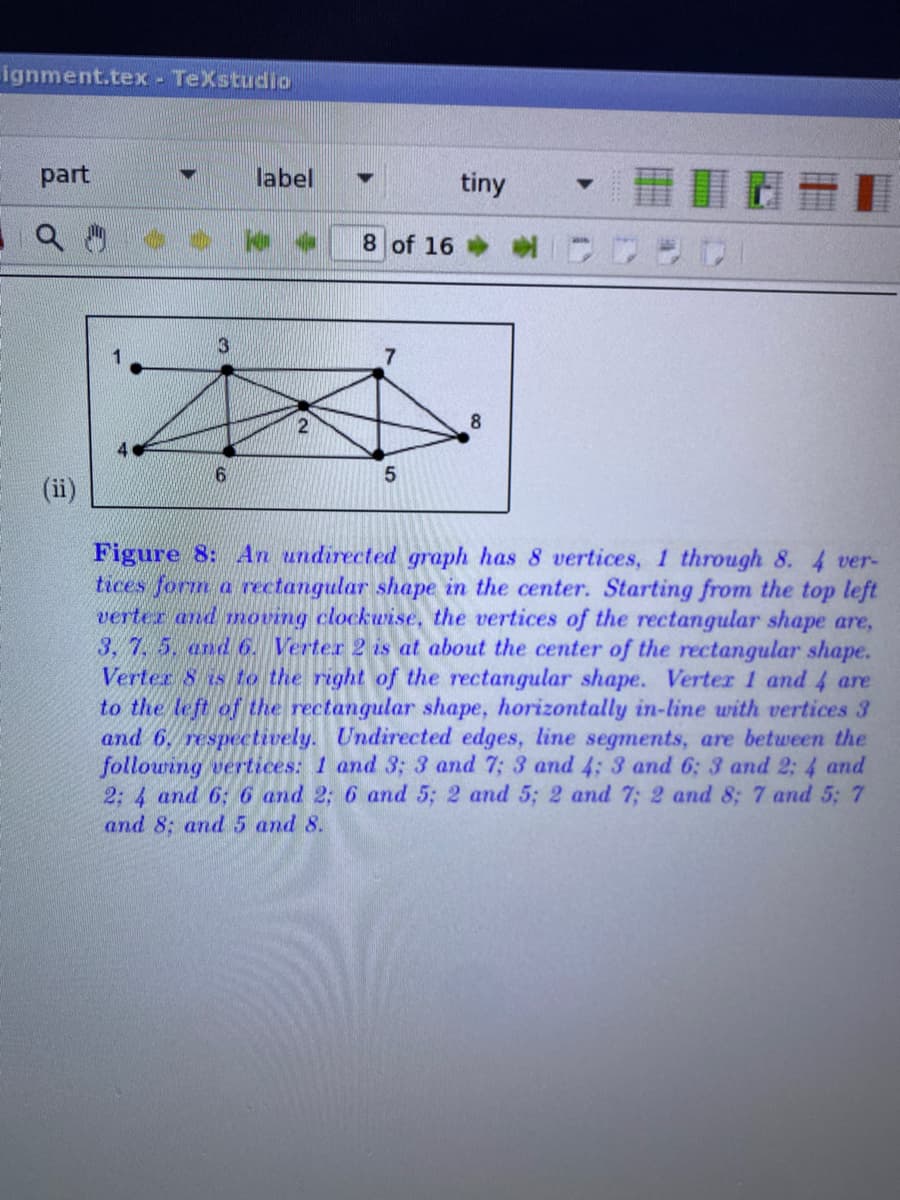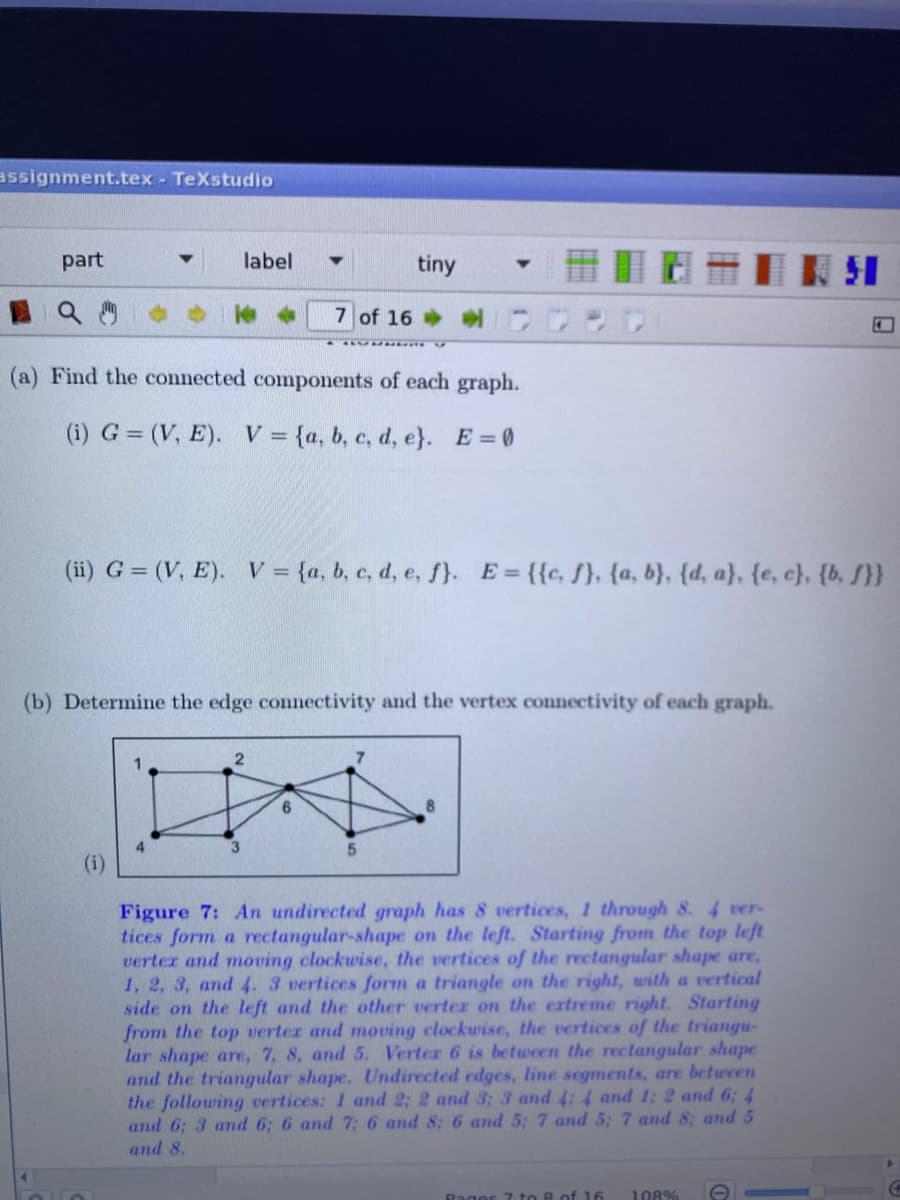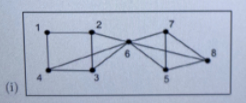Discrete Mathematics I need help with this 2 part problem Part a Part b
Holt Mcdougal Larson Pre-algebra: Student Edition 2012
1st Edition
ISBN:9780547587776
Author:HOLT MCDOUGAL
Publisher:HOLT MCDOUGAL
Chapter12: Angle Relationships And Transformations
Section12.5: Reflections And Symmetry
Problem 20E
Related questions
Question
Discrete Mathematics
I need help with this 2 part problem
Part a
Part b

Transcribed Image Text:ignment.tex - TeXstudio
part
label
tiny
8 of 16
3
7.
(ii)
Figure 8: An undirected graph has 8 vertices, 1 through 8. 4 ver-
tices form a rectangular shape in the center. Starting from the top left
verter and moving clockwise, the vertices of the rectangular shape are,
3. 7. 5. and 6. Verter 2 is at about the center of the rectangular shape.
Verter 8 is to the right of the rectangular shape. Verter 1 and 4 are
to the left of the rectangular shape, horizontally in-line with vertices 3
and 6. respectively. Undirected edges, line segments, are between the
following vertices: 1 and 3; 3 and 7; 3 and 4: 3 and 6: 3 and 2: 4 and
2: 4 and 6: 6 and 2; 6 and 5; 2 and 5; 2 and 7; 2 and 8; 7 and 5: 7
and 8: and 5 and 8.

Transcribed Image Text:assignment.tex - TeXstudio
part
label
tiny
7 of 16
(a) Find the connected components of each graph.
(i) G = (V, E). V = {a, b, c, d, e}. E =0
(ii) G = (V, E). V= {a, b, c, d, e, f).
E = {{c, f}, {a, b}, {d, a}, {e, c}, {b, S}}
(b) Determine the edge connectivity and the vertex connectivity of each graph.
3
Figure 7: An undirected graph has 8 vertices, 1 through 8. 4 ver-
tices form a rectangular-shape on the left. Starting from the top left
verter and moving clockwise, the vertices of the rectangular shape are,
1, 2, 3, and 4. 3 vertices form a triangle on the right, with a vertical
side on the left and the other verter on the extreme right. Starting
from the top verter and moving clockuise, the vertices of the triangu-
lar shape are, 7, 8, and 5. Verter 6 is between the rectangular shape
and the triangular shape. Undirected edges, line segments, are between
the following vertices: 1 and 2; 2 and 3; 3 and 4: 4 and 1: 2 and 6; 4
and 6: 3 and 6: 6 and 7; 6 and 8; 6 and 5: 7 and 5: 7 and 8; and 5
and 8.
Rager 7 to 8 of 16
108%
Expert Solution
Step 1
To find-
- Find the connected components of each graph.
b. Determine the edge connectivity and the vertex connectivity of each graph.


Trending now
This is a popular solution!
Step by step
Solved in 3 steps with 6 images

Recommended textbooks for you

Holt Mcdougal Larson Pre-algebra: Student Edition…
Algebra
ISBN:
9780547587776
Author:
HOLT MCDOUGAL
Publisher:
HOLT MCDOUGAL

Algebra: Structure And Method, Book 1
Algebra
ISBN:
9780395977224
Author:
Richard G. Brown, Mary P. Dolciani, Robert H. Sorgenfrey, William L. Cole
Publisher:
McDougal Littell

Glencoe Algebra 1, Student Edition, 9780079039897…
Algebra
ISBN:
9780079039897
Author:
Carter
Publisher:
McGraw Hill

Holt Mcdougal Larson Pre-algebra: Student Edition…
Algebra
ISBN:
9780547587776
Author:
HOLT MCDOUGAL
Publisher:
HOLT MCDOUGAL

Algebra: Structure And Method, Book 1
Algebra
ISBN:
9780395977224
Author:
Richard G. Brown, Mary P. Dolciani, Robert H. Sorgenfrey, William L. Cole
Publisher:
McDougal Littell

Glencoe Algebra 1, Student Edition, 9780079039897…
Algebra
ISBN:
9780079039897
Author:
Carter
Publisher:
McGraw Hill

Algebra & Trigonometry with Analytic Geometry
Algebra
ISBN:
9781133382119
Author:
Swokowski
Publisher:
Cengage
